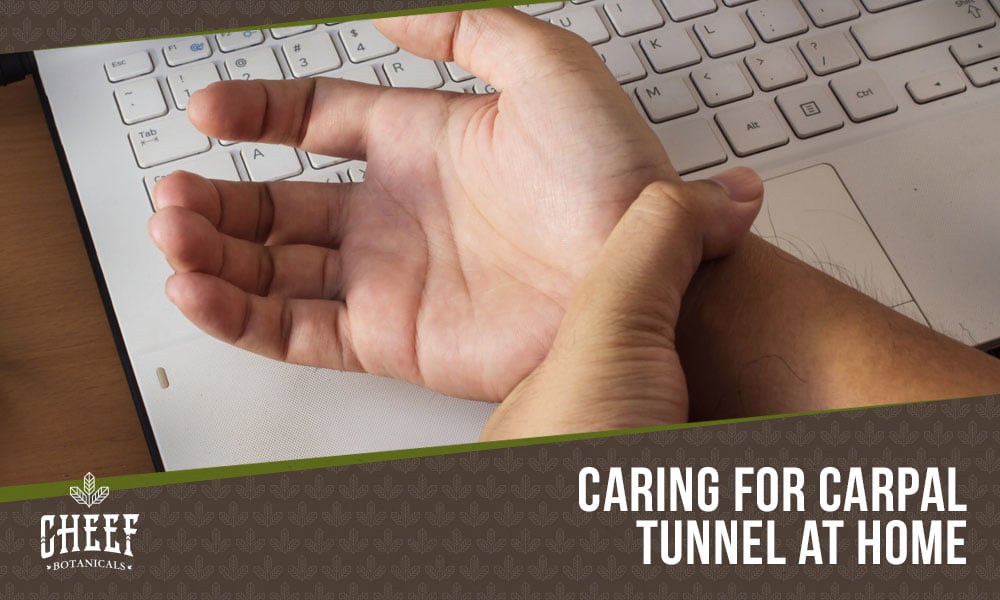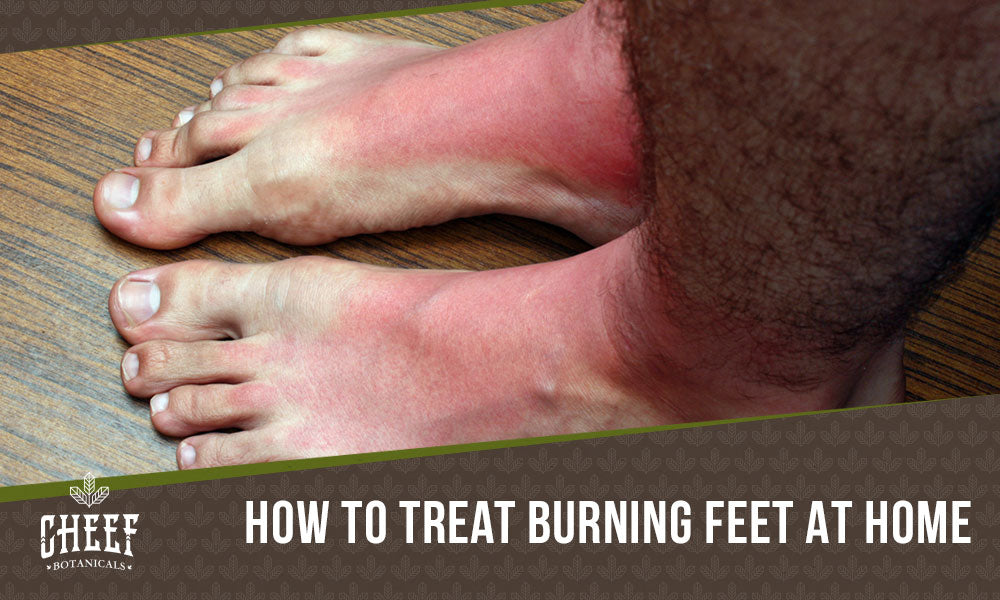You're just minding your own business, typing an important document for work when you feel a strange tingling feeling in your wrist. Your hand starts to feel numb. That's carpal tunnel. This syndrome can be quite frustrating, but luckily there are home remedies for carpal tunnel that will reduce its symptoms.
Carpal tunnel affects your wrist, hands, and fingers. It usually makes them feel numb or tingly. Sometimes you can even feel pain and discomfort. It's important to pinpoint the cause so you can figure out a proper treatment plan going forward. There are ways to instantly improve your carpal tunnel symptoms without even leaving home!


What is Carpal Tunnel?
Carpal tunnel syndrome results in tingling and weakness in the wrists, hands, and fingers due to pressure on the median nerve. To gain a clearer understanding of the condition and its causes, let’s take a brief anatomy lesson on the hand and arm. The carpal tunnel is actually a passageway on the palm of your hand that's surrounded by bones and ligaments. The median nerve runs the entire length of your arm, including through the carpal tunnel passage. It ends in your hand, controlling the movement and feeling of your thumb and fingers (except the pinky). When the median nerve is compressed, it can lead to carpal tunnel syndrome. You'll experience the following in your hand and/or arm:- Tingling or numbness: This will usually start in your fingers, then your hand. It's usually the thumb and index finger. Sometimes the middle or ringer fingers will also be affected, but it will never be your little finger.
- Shock: This feeling in your fingers can grow stronger, sometimes resulting in a sensation that mirrors an electric shock.
- Wrist pain: While the tingling and numbness often start in your fingers, it will sometimes travel up your wrist and arm. You'll usually notice this when you're ribbing a steering wheel or holding your phone.
- Weakness: Your hand might become weak, causing you to drop objects or have a weak grip. This is often due to numbness or a pinched muscle.
Is Carpal Tunnel Common?
Carpal tunnel syndrome is actually quite common. It affects about three to six percent of adults, making it the most common entrapment neuropathy (condition of nerve compression). One reason it's so common is the variety of ways in which you can get the syndrome, from diseases to lifestyle.
What Causes Carpal Tunnel?
As we said before, carpal tunnel syndrome is caused by pressure on a certain nerve in your hand. This often happens with repetitive movements, though other traits like weight, genetics, and gender come into play as well. Here are a few factors that make the syndrome more likely.- Women are three times more likely to get carpal tunnel. It's not exactly known why, but it could be due to them having smaller carpal tunnels.
- You're more likely to get carpal tunnel if you have a family member with small carpal tunnels.
- If you move your arm, hand, or wrist in the same motions over and over for work, you are more likely to develop this syndrome. This often occurs among musicians, bakers, or hairstylists, even cashiers and assembly line workers.
- If you have previously damaged your wrist, like a fracture or a dislocation, carpal tunnel is more common.
Repetitive Motions
People who move their hands and wrists often are no strangers to carpal tunnel. After typing eight hours a day, it's not uncommon to get very numb fingers. Other professions that use their fingers and wrists a lot can also experience numbness and tingling, especially if the motions are repetitive. This includes assembly line workers, bakers, and musicians.Vibrations
Constant exposure to vibrations, like when using hand tools or power tools for prolonged periods of time, can cause carpal tunnel syndrome. People that work in construction and other trades should be aware of this risk.Obesity
Research has found that recent weight gain can increase fluid accumulation in the tissue spaces within the carpal tunnel. This is why it's more common for overweight people to get experience this irritating condition.Diabetes
Diabetes causes the tendons of the carpal tunnel to become glycosylated. That's due to higher blood glucose levels in the body, leading to inflamed tendons. The excess sugars form a "biological superglue" that makes your tendons unable to slide as freely, making your wrist stiff.Arthritis
Arthritis can lead to carpal tunnel. About 10% of people with rheumatoid arthritis develop carpal tunnel syndrome as well. Sometimes arthritis can deform the small bones in the wrist, changing the space within the carpal tunnel. This puts pressure on the median nerve.Pregnancy
It's actually sort of crazy how many pregnant people develop carpal tunnel syndrome! About 31 to 62% of pregnant patients end up with the condition. This is because many pregnant people experience swelling. Most pregnant people will get extra puffy in their face, legs, and feet. But some individuals will get swelling in the wrist, resulting in carpal tunnel syndrome.Hypothyroidism
Hypothyroidism can cause a fluid buildup if left untreated. This puts pressure on the nerves in your arms and legs. Low thyroid can sometimes cause carpal tunnel syndrome, which leads to tingling, pain, and numbness where the nerve is damaged.Fractures
Trauma to the wrist can make you more susceptible to carpal tunnel syndrome. If you have injured your wrist in the past, keep a close watch on how you move your wrists to avoid carpal tunnel.Home Remedies for Carpal Tunnel
If you suspect that you have carpal tunnel syndrome, visit a doctor. They can officially diagnose you and provide you with a treatment plan to reduce your symptoms. But meanwhile, there are some home remedies for carpal tunnel that can ease your symptoms.Watch Your Hand Placement
People with office jobs or who are always on their computer, whether it's writing or playing games, are at a high risk of carpal tunnel syndrome. Make sure your hands are not lower than your wrists and maintain a proper posture. This will lessen your chances of developing the condition.Lifestyle Changes
If you are experiencing symptoms due to a certain activity, try taking a break from that activity. It's often the repetitive nature of the movements that cause carpal tunnel syndrome. For example, if you're working on a renovation project, try reducing the amount of time you're using power tools each day. Or take breaks from writing your book more often and for longer periods.Exercises
If you want to reduce carpal tunnel symptoms, it's important to stretch and strengthen your wrists. Find routines that glide your nerves so they can move better within your hand. One popular exercise is simply shaking your wrists. Shake your hands as if you just washed them and are trying to get off the excess water. Doing this for a minute every hour will keep the flexor muscles in your hands from cramping and tightening. There's a stretch you can try to further improve your wrists. Place one arm straight out in front of you with the elbow straight. Your wrist should be extended with your fingers facing the floor. Use your other hand to apply gentle pressure to the downward-facing hand. Stretch your wrist and fingers as far as you can. Hold that position for about 20 seconds. Do this stretch on each wrist three times each. Do this stretch every hour. You'll notice an improvement in your wrist's flexibility after doing this for a few weeks.Related: Muscle Recovery: The Secret to Professional Work Out Regimens




 CBD Gummies - Top Seller
CBD Gummies - Top Seller
 CBD + THC Gummy - Excellent Choice
CBD + THC Gummy - Excellent Choice
 CBD Hemp Flower - Highly Rated
CBD Hemp Flower - Highly Rated
 Full Spectrum CBD Oil - Good Value
Full Spectrum CBD Oil - Good Value



Leave a comment
This site is protected by hCaptcha and the hCaptcha Privacy Policy and Terms of Service apply.